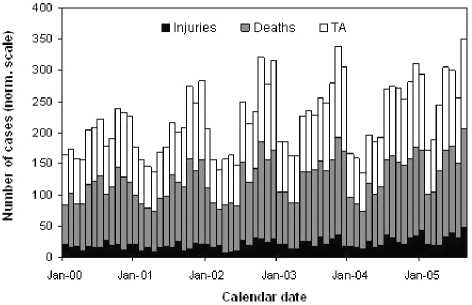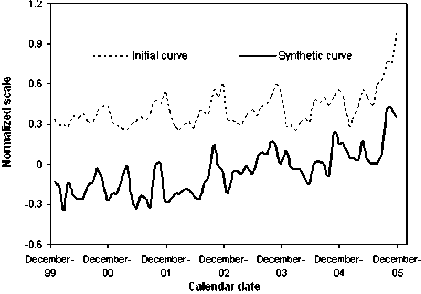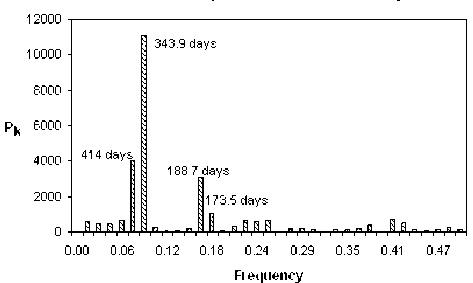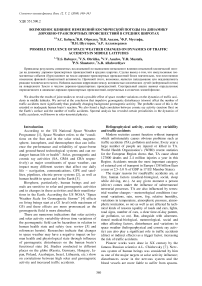Possible influence of space weather changes on dynamics of traffic accidents in middle latitudes
Автор: Babayev E.S., Obridko V.N., Asadov V.V., Mustafa F.R., Shustarev P.N., Allahverdiyev A.R.
Журнал: Солнечно-земная физика @solnechno-zemnaya-fizika
Статья в выпуске: 12 т.2, 2008 года.
Бесплатный доступ
We describe the results of joint studies to reveal a possible effect of space weather variations on the dynamics of traffic accidents in middle latitudes. We arrived at the conclusion that impulsive geomagnetic disturbances (storms) affect the number of traffic accidents more significantly than gradually changing background geomagnetic activity. The probable cause of this is the retarded or inadequate human brain's reaction. We also found a high correlation between cosmic ray activity (neutron flux) on the Earth's surface and the number of traffic accidents. Spectral analysis has revealed certain periodicities in the dynamics of traffic accidents, well-known in solar-terrestrial physics.
Короткий адрес: https://sciup.org/142103285
IDR: 142103285 | УДК: 551.590.2
Текст научной статьи Possible influence of space weather changes on dynamics of traffic accidents in middle latitudes
According to the US National Space Weather Programme [1], Space Weather refers to the “conditions on the Sun and in the solar wind, magnetosphere, ionosphere, and thermosphere that can influence the performance and reliability of space-borne and ground-based technological systems and can endanger human life or health”. Solar, geomagnetic and cosmic ray activities (SA, GMA and CRA respectively) as major constituents of space weather, can impact many different sectors that affect our daily life – navigation, communications, GPS and satellites, pipelines, electric power systems [2], as well as human health in space and in the Earth [3].
Biosphere, particularly, human beings and animals are sensitive to solar and geomagnetic activities and to changes in these activities and their manifestations in the Earth. According the US NOAA “Space Weather Scale for Geomagnetic Storms” [4] effects on living beings start at a G1 level (with maximum of G5) and these effects are more pronounced as the geomagnetic field is more disturbed.
There are numerous indications that solar activity and solar activity variability-driven time variations of the geomagnetic field can be hazardous in relation to human health state and safety (see: review [5] and references herein). Researches indicate that changes in space weather may have a negative impact on human health and physiological state through influence of geomagnetic disturbances on the human brain’s functional state [6]. Studies conducted in different places on the globe (Russia, Germany, Hungary, Japan, Poland, Azerbaijan, Israel, Lithuania, etc.) show on correlations between high solar and geomagnetic activity and increased traffic accidents.
Heliogeophysical activity, cosmic ray variability and traffic accidents
Modern societies cannot function without transport which unfortunately causes obvious problems such as traffic accidents (TA), pollution and noise. Every year a large number of people are injured or killed in TA. World Health Organization’s (WHO) recent statistics for the European Region shows that, TA cause about 127000 deaths and 2.4 million injuries a year in this Region. Accidents remain the most important category of external cost of transport in Europe (158 billion Euro a year or 2.5–3.0 % of GDP in 17 EU Member States).
The major reasons for road/traffic accidents are, at first, human factors (medical-biological, social, sleep while driving, etc.). At any given moment a person (driver) comes under the influence of subterranean/ terrestrial processes. TA are also influenced by terrestrial weather changes – meteorological conditions (seasonal variations, rain, snow, fog, relative humidity, variations in temperature, atmospheric pressure, atmospheric ionization, so on) as well as are affected by technical kinds of reasons (quality of roads and cars, lights, road signs, number of cars, a clear time-of-day pattern, air pollution, so on). But, alongside with aforementioned medical-biological, meteorological, social and other affecting factors, disturbances and variations in space weather (heliogeophysical and cosmic ray activity) can also play a significant role in traffic accidents (direct or indirect effects) as a trigger factor, increasing the risk of traffic accidents.
Pioneer works were done in XX century by the famous Russian scientist A.L. Chizhevsky [7]. Nervous system of human beings was considered by him as one of the major targets at solar activity influence; disturbances occur in the nervous system and the blood vessels are more liable to suffer from spasms.
At such times the number of road accidents increases, and so on.
Limitation of this paper does not allow reviewing major works on the considered subject published mainly during last 50 years. We refer readers to some of the recently published papers [8–14] which show that this problem is still actual one.
In this paper we have investigated a possible influence of changes in space weather conditions on dynamics of traffic accidents in middle latitude location (40 ° 23 ‘ N, 49 ° 51 ‘ E) - in Grand Baku Area, for time period 2000–2005.
Material and methods
With purposes of study the possible impact of space weather changes (SA, GMA and CRA) on the dynamics of TA in Grand Baku Area (middle-latitude capital city with millions of inhabitants + Absheron Economic Region, where approximately 50 % of domestic cars are concentrated [15]), we have used TA data (Fig. 1) for the time period 2000–2005 on the basis of daily official reports of the Department of Statistics and Department of Public Relations, Baku City Main Traffic Police Department, Ministry of Internal Affairs of the Republic of Azerbaijan.
Considered period corresponds to maximum and declining phase (with intense geomagnetic storms, as “Halloween Events” in October–November 2003) of solar cycle 23 and relative socio-economical stability in Azerbaijan (including improved quality of roads and traffic-related conditions, as well as rising amount of modern and reliable cars, in comparison to the Soviet period). Data contain all of technical and medical details for TA, cars, injured and killed persons. Data were cleaned, as much as possible, from socio-technical factors. Daily “migration” of cars from province to Baku as well as a trend in rising number of cars was taken into account. Averaging on months enabled to minimize the influence of quasi-weekly rhythms, which are of more social nature.
The following space weather parameters were used in our studies for the same time period: for SA – sunspot number (SNN) and solar radio flux at 10.7 cm wavelength ( F 10.7); for GMA – A p, C p, and A m geomagnetic indices; for CRA – the neutron monitoring data on the Earth’s surface.
Spectral (Fourier), correlation and cross-correlation analyses were performed with the help of software STATISTICA (ver. 6) and SPSS (ver. 12).
Improved statistical analyses method, developed by authors, enabled to study comparative contribution of considered agents of SA, GMA and CRA in the so called “integrated space weather influence index”, also introduced by authors. Synthetic curve taking into account these influences was calculated and compared with initial curve representing the real dynamics of TA.
Seasonal variations were studied and influence of meteorological and technical factors were analyzed.
Results and discussion
Application of improved by authors statistical analyses method and calculation of the synthetic spectrum has revealed that significant contribution came from geomagnetic D st index (50 %) and partly from SSN (30 %) which were displayed in the aforementioned “integrated space weather influence index” (ISWII):
ISWII (traffic accidents) = 0.5Dst + 0.3 SSN + 0.18 F10.7 + 0.02 Ap + const, where F10.7 is the solar radio flux at wavelength 10.7 cm and Ap is the geomagnetic index.
Mechanism of calculation of the synthetic curve is not provided here due to limitation of paper size. Synthetic curve was “built up” (Fig. 2) step-by-step until the obtained synthetic curve fitted closely to the initial (or real) curve; correlation coefficients between these (final) curves were: parametric Pearson r = 0.697 with probability of p = 1.02 - 10-11; non-parametric Kendall r = 0.377 ( p = =3.01 • 10-6) and Spearman r = 0.547 (p = 0.000001).
There was an inverse correlation (Pearson) with SSN, F 10.7, and D st and non-significant correlation with geomagnetic indices ( A p , C p and A m ) describing gradual changes of geomagnetic field. There was found a relatively high correlation between CRA (neutron activity on the Earth’s surface) and TA; this result coincides with ones from other studies [12, 13]. The chain effect “SA-cosmic rays-variations in ozone content, cloudiness formation, changes in atmospheric temperature and pressure, increased ionization, circulation – tropospheric weather state – human health/physiological state – TA” could be considered as one of mechanisms in explanation of this effect.
Studies showed that there was no certain dependence of TA on seasonal variations and meteorological factors meanwhile winter months were comparatively worth ones for TA.

Fig. 1. Dynamics of traffic accidents and related deaths and injuries. Baku data, 2000–2005.

Fig. 2. Traffic accidents dynamics (initial curve) and so called synthetic curve.

Fig. 3. Power spectrum of traffic accidents. Baku data, 2000–2005. Major periodicities are shown on curves (in days).
Fourier analysis revealed certain periodicities which are shown in power spectrum of TA data (Fig. 3).
Periods which are approximately equal and/or close to the determined periodicities, are well displayed in changes of heliogeophysical parameters [16, 17]. For example, 1.03 year periodicity was found in the lower frequency part of the power spectrum of variations of the mean magnetic field of the Sun for 1968–2000 [18]. Annual variation (in our case, close value is 343.9 days) is often more clear because the solar wind distribution is asymmetric or shifted with respect to equator. Another reason could be the Earth’s orbit around the Sun taking it to different helio-latitudes. 414-day period is close to the one found in solar wind variations.
At the Earth’s surface a space weather event manifests itself as a rapid variation of the geomagnetic field and geomagnetic storms of various intensities. Results of the experimental studies [6, 19] of influence of the periodical and aperiodical changes of geomagnetic activity upon human brain, human health and psychoemotional state show that weak and moderate geomagnetic storms do not cause significant changes in the brain’s bioelectrical activity and exert only stimulating influence while severe disturbances of geomagnetic conditions cause negative influence, seriously disintegrate brain’s functionality, activate braking processes and amplify the negative emotional background of an individual. It is also shown that geomagnetic disturbances affect mainly emotional and vegetative spheres of human beings. In our opinion, human being’s physiological state and brain’s bioelectrical activity, affected by major and severe geomagnetic storms negatively, may result in the inadequate reaction and its retard in relation to the situation leading to the relatively increased number of traffic accidents.
Conclusions
This paper can be considered as a new level study conducted for revealing a possible influence of space weather changes on dynamics of traffic accidents in middle latitude locations. Obtained results were compared with ones from different studies covering different locations and using various methods. Our results, based on the analysis of new, detailed and long-series data prove the existence of influence of heliogeophysical factors on dynamics of traffic accidents found in previous studies of different authors [8–13, 20–30]. This paper reveals the leading role of only major and severe geomagnetic disturbances in this influence at middle latitudes.


